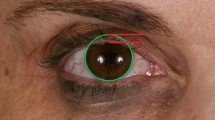Abstract
Background
Photography plays a pivotal role in patient education, photo-documentation, preoperative planning and postsurgical evaluation in plastic surgeries. It has long been serving as a bridge that facilitated communication not only between patients and doctors, but also among plastic surgeons from different countries. Although several basic principles and photographic methods have been proposed, there is no internationally accepted photography that could provide both static and dynamic information in blepharoplasty. In this article, we introduced a novel six-position, frontal view photography for thorough assessment in blepharoplasty.
Methods
From October 2013 to January 2017, 1068 patients who underwent blepharoplasty were enrolled in our clinical research. All patients received six-position, frontal view photography. Pictures were taken of the patients looking up, looking down, squeezing, smiling, looking ahead and with closed eyes. Conventionally, frontal view photography only contained the last two positions. Then, both novel six-position photographs and conventional two-position photographs were used to appraise postsurgical outcomes.
Results
Compared to conventional two-position, frontal view photography, six-position, frontal view photography can provide more detailed, thorough information about the eyes. It is of clinical significance in indicating underlying adhesion of skin/muscle/fat according to individual’s features and assessing preoperative and postoperative dynamic changes and aesthetic outcomes.
Conclusion
Six-position, frontal view photography is technically uncomplicated while exhibiting static, dynamic and detailed information of the eyes. This innovative method is favorable in eye assessment, especially for revision blepharoplasty. We suggest using six-position, frontal view photography to obtain comprehensive photographs.
Level of Evidence V
This journal requires that authors assign a level of evidence to each article. For a full description of these Evidence-Based Medicine ratings, please refer to the Table of Contents or the online Instructions to Authors www.springer.com/00266.










Similar content being viewed by others
References
Rogers BO (1991) The first pre- and post-operative photographs of plastic and reconstructive surgery: contributions of Gurdon Buck (1807–1877). Aesthet Plast Surg 15:19–33
Becker DG, Tardy MJ (1999) Standardized photography in facial plastic surgery: pearls and pitfalls. Facial Plast Surg 15:93–99
Dini GM, Gozzano R, Ferreira RB et al (2014) Mirror, mirror on the wall, which breast is bigger of them all. Plast Reconstr Surg Glob Open 2:e105
Lahousen T, Linder D, Gieler T et al (2017) Body dysmorphic disorder: diagnostics and treatment in cosmetic dermatology. Hautarzt 68:973–979. https://doi.org/10.1007/s00105-017-4064-7
Swamy RS, Sykes JM, Most SP (2010) Principles of photography in rhinoplasty for the digital photographer. Clin Plast Surg 37:213–221
Persichetti P, Simone P, Langella M et al (2007) Digital photography in plastic surgery: how to achieve reasonable standardization outside a photographic studio. Aesthet Plast Surg 31:194–200
Hu JW, Byeon JH, Shim HS (2016) Simultaneous double eyelid blepharoplasty and ptosis correction with a single-knot, continuous, nonincisional technique: a five-year review. Aesthet Surg J 36:14–20
Thorne CH (2013) Grabb & smith’s plastic surgery. Lippincott Williams & Wilkins, Philadelphia
Park DH, Park SU, Lee BK et al (2014) Medial epicanthoplasty without a vertical scar. Ann Plast Surg 73:8–11
Zhao J, Qi Z, Zong X et al (2016) A modified method combining Z-epicanthoplasty and blepharoplasty to develop out-fold type double eyelids. Aesthetic Plast Surg 40:48–53
Jin Y, Lyu D, Chen H et al (2017) Invisible scar medial epicanthoplasty: a novel approach. J Plast Reconstr Aesthet Surg 70:952–958
Weissler JM, Stern CS, Schreiber J et al (2016) The evolution of photography and three-dimensional imaging in plastic surgery. Plast Reconstr Surg 139:761–769
Hagan KF (2008) Clinical photography for the plastic surgery practice–the basics. Plast Surg Nurs 28(188–192):193–194
Rhee SC (2017) A simple method for international standardization of photographic documentation for aesthetic plastic surgery. Aesthet Plast Surg 41:461–465
Henderson JL, Larrabee WJ, Krieger BD (2005) Photographic standards for facial plastic surgery. Arch Facial Plast Surg 7:331–333
Tepper OM, Steinbrech D, Howell MH et al (2015) A retrospective review of patients undergoing lateral canthoplasty techniques to manage existing or potential lower eyelid malposition: identification of seven key preoperative findings. Plast Reconstr Surg 136:40–49
Acknowledgements
This study was supported by Education financial support for Peking Union Medical College (No. 10023201504022).
Author information
Authors and Affiliations
Corresponding author
Ethics declarations
Conflict of interest
The authors have no conflicts of interest to disclose.
Ethical Approval
All procedures performed in studies involving human participants were in accordance with the ethical standards of the clinical research committee of plastic surgery hospital and with the 1964 Declaration of Helsinki and its later amendments or comparable ethical standards.
Additional information
Cheng Zhang and Xiaoshuang Guo are joint first authors.
Rights and permissions
About this article
Cite this article
Zhang, C., Guo, X., Han, X. et al. Six-Position, Frontal View Photography in Blepharoplasty: A Simple Method. Aesth Plast Surg 42, 1312–1319 (2018). https://doi.org/10.1007/s00266-018-1104-3
Received:
Accepted:
Published:
Issue Date:
DOI: https://doi.org/10.1007/s00266-018-1104-3




